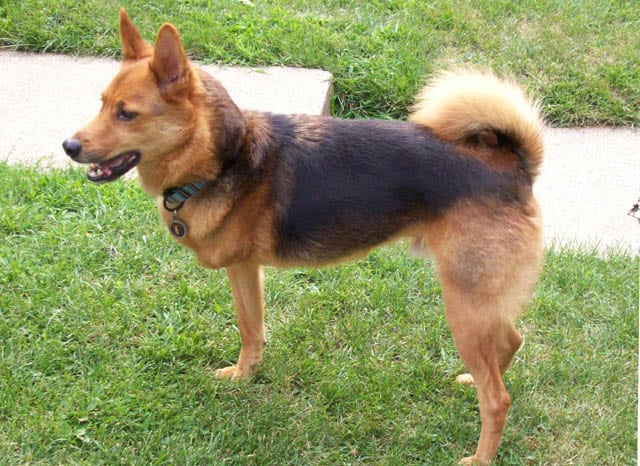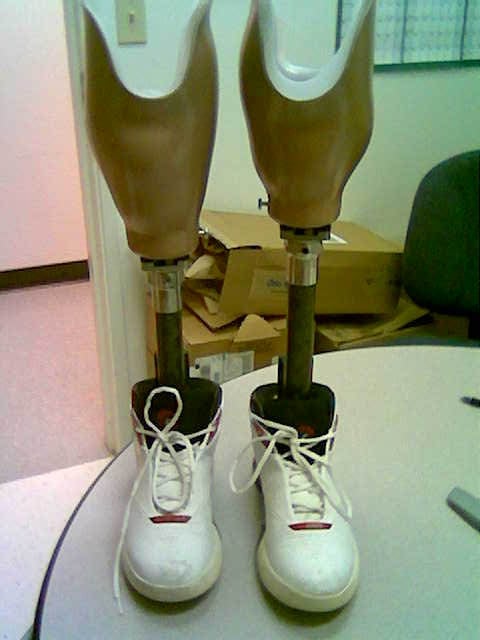The following guest blog post was generously contributed by Meg Sligar, dog mom to Three Legged Max. If you would like to help out by contributing a post, please contact us today.
 When most people find out I have a three legged dog, their first question is “Have you made a leg for him yet?” That’s because I’m a prosthetist—I make artificial arms and legs for people. It’s a rewarding profession with new challenges each day. So, when I was looking for my new best friend, it was only natural that I had my eye out for a three legged dog.
When most people find out I have a three legged dog, their first question is “Have you made a leg for him yet?” That’s because I’m a prosthetist—I make artificial arms and legs for people. It’s a rewarding profession with new challenges each day. So, when I was looking for my new best friend, it was only natural that I had my eye out for a three legged dog.
Searching PetFinder.com I found a terribly distorted picture of a small brown and black tripawd named Max listed as “special needs.” Oh, he has special needs alright, but it’s not because he’s missing a leg—he just LOVES attention! He even blogs! For the past two years, Max has been my main man and the reason I can’t wait to come home after work.
Have I made a prosthetic leg for him? No, and I doubt I ever will. Max lost his leg when he was hit by a car, and while he does have a short residual limb, or stump, there really isn’t enough left to control a prosthesis. The majority of dogs who lose a leg have it amputated at the shoulder or hip level. Prosthetically, there isn’t much that can be done for them. Besides the fact that it would be very difficult to design a socket that would suspend well on such a short stump (if any stump remains at all), a prosthesis would have to include 2-3 joints—ankle/wrist, knee/elbow, and possible hip/shoulder.
 That’s a whole heck of a lot of artificial joints and a dog would have a hard time trying to control them. Even for humans using a prosthesis, that’s a very difficult level of amputation to fit effectively. For dogs, it’s just not practical. In fact, a prosthesis would most likely slow them down and possibly cause injury.
That’s a whole heck of a lot of artificial joints and a dog would have a hard time trying to control them. Even for humans using a prosthesis, that’s a very difficult level of amputation to fit effectively. For dogs, it’s just not practical. In fact, a prosthesis would most likely slow them down and possibly cause injury.
Dogs typically adjust very well to life on three legs, and that’s why I haven’t pursued trying to design something for Max. From my experience, the smaller the dog, the better he’ll do on three legs. Fortunately for Max, his half German Shepard Dog self is also half Shiba Inu, so he’s on the small side.
I do think about a prosthesis sometimes, though, because I wonder in the long term how he’ll be. He’s 9 years old now and gets around just fine, but the stress on his front leg is high. I’ve read that dogs carry 60% of their weight on their front legs, so that’s 60% on one leg and 20% on each of the others. He’s got the typical front-leg tripawd stance where he puts his one front paw on the ground directly below the center of his chest, instead of to the side (human amputees do the same thing, bringing their good leg in to midline for balance).
Now, there are some tripawds out there who are only missing a paw. If the dog has his amputation below the “elbow” or “knee”, then a prosthesis may be a good idea. Either a plastic or carbon socket would be easily suspended on such a long stump. Also, a prosthesis at this level can be functional and easy to use. From my interactions with these low level amputee dogs who don’t have prostheses, I’ve noticed that they tend to stumble more, not knowing exactly what to do with the short leg.
 If you’re considering a prosthesis for your tripawd, I suggest getting him fitted as soon as possible (after healing) after surgery. Just like with people, the longer he waits for a prosthesis, the less likely he is to use it. And unlike people, you can’t just tell him how to use it and expect him to follow directions. You can’t say “go ahead, put weight on it, you can trust it.” Well, you can, but chances are he’s not going to listen. It’ll take some practice, but he can adapt to a prosthesis the same way he can adapt to life on three legs. . . at his own pace.
If you’re considering a prosthesis for your tripawd, I suggest getting him fitted as soon as possible (after healing) after surgery. Just like with people, the longer he waits for a prosthesis, the less likely he is to use it. And unlike people, you can’t just tell him how to use it and expect him to follow directions. You can’t say “go ahead, put weight on it, you can trust it.” Well, you can, but chances are he’s not going to listen. It’ll take some practice, but he can adapt to a prosthesis the same way he can adapt to life on three legs. . . at his own pace.
The most important thing when fitting a dog with a prosthesis is to pay close attention to his skin. Skin breakdown can be a problem for human and canine amputees. You have to pay close attention because your tripawd can’t just say “it hurts” like a person can. Vigilance is absolutely necessary.
And you have to consider whether you will be able to leave the prosthesis on your dog when he’s out of your sight. Will he eat it? We have several people each year come in to get new leg braces because their dog ate them—plastic must smell mighty good! Do you want your dog to have a “sometimes foot?” Remember his safety is the priority.
If you’re willing to take the prosthetic journey with your best friend, a good place to start is to contact a local prosthetist. Many prosthetists would be willing to take on a canine patient, and several already have. Just call and see if they’re interested.
If you can’t find anything locally, there are a few companies out there that specialize in pet prostheses, and you may be able to get it done by mail. OrthoPets is a Denver based company that does just that. They also make orthoses (braces) for dogs with various limb injuries. You can check out one of their patients, Andre, in the September 21 issue of People Magazine. Poor Andre got caught in an illegal trap and chewed two of his paws off to save his life. He now has two prosthetic feet! I haven’t worked with them, but from what I’ve heard, they do good work.
I’ve been asked about carts, as well. In my opinion, if your dog’s only health issue is the one missing leg, there’s no need for a cart. It would only make him dependent on the cart, when he could have adjusted fine without it. But if the tripawd has injury or pain in any of his other legs, especially the one opposite the amputated leg, then a cart would be something to consider. If Max starts to have problems from overuse syndrome as he gets older, I just may have to rig something up for him.
Just think about what would make your dog happiest—maybe hopping around on three legs is the way to go, maybe a cart, maybe a prosthesis. If I ever come up with a shoulder/elbow/wrist prosthesis for Max, I’ll be sure to let you know.
Wow! Thank you Meg for such an interesting post! We just recently pulled a 8 month old GSD into a rescue group I belong to. He had one paw missing and they were going to amputate his whole leg. I suggested a prosthetic but did not really have much info to give them nor did I have time to do the research, he was scheduled for surgery a couple of days after I found out about him. Well, they went ahead and took his leg and he is doing great. Its just so frustrating and it seems so sad that he had to lose his whole leg. Rescue probably could not have afforded a prosthesis for him though.
I will definitely save this post and your name for future reference!
Martha
BTW….Codie Rae says Three Legged Max is the cutest!